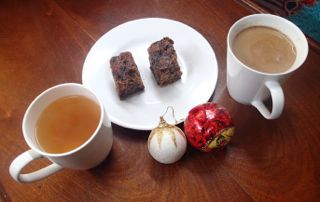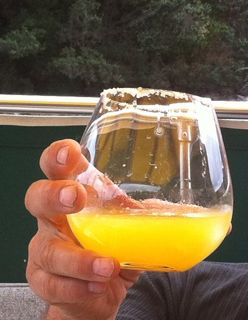Tauranga to Tuhua
Tauranga to Tuhua Janet, December 10
“Two clicks to starboard,” calls a voice from the cabin.
I cross the cockpit and push twice on the right-hand button of the autopilot, steering the boat two degrees closer to our course.
I look at the sky, vast, unencumbered by land, unlike Wellington Harbour which is surrounded by hills that play havoc with the sky-scape. Out on the open sea like this you can see the weather patterns in their full glory, for example the full roll cloud of a front bearing down on you. To port (left for you landlubbers), and over the dark ranges of Coromandel, lies a bank of dark clouds, which would hit us later this afternoon if we lingered out here. Above us the sun occasionally peeks through the gloomy 90% cloud cover. Twenty knots of wind was forecast for this morning but we’re motoring, and have been off and on for hours. All the better for getting the freezer down though. On board we have a fridge and freezer run off a compressor attached to the engine. This means running the engine for an hour a day to keep the coolant circulating and chilling our precious provisions.
“If that thing breaks down again we’re not fixing it,” David has declaimed many times in the past.
Cost $600 last time. But the freezer is my life-blood. It is home to the materials of my creativity, my sanity at times, that great source of joy - cooking. I’d dig deep into my own pocket to keep it going if need be.
I gaze ahead and a faint mound starts to take form. Mayor Island the locals call it, but its correct name has been reclaimed we are to learn – Tuhua. Its dark silhouette slowly transforms into the shapes of trees and cliffs. Much of it is a marine reserve, and a DOC conservatory we read.
“Cup of tea?” the voice calls from the cabin.
“Absolutely.”
“Christmas cake?”
Heaven.
We spend our time texting friends and family while in range, and occasionally pulling on a sheet (that’s the rope that goes to the sail), all the hard work being done at the beginning of the journey – hoisting the main (the biggest sail), letting the jib out (the front sail), coiling and stowing mooring lines, lifting fenders, and reefing the main as the wind rallies briefly.
Arriving
“Reverse,” David waves his arm back towards me.
He is on the bow letting the anchor down. The chain rattles over its roller, settling on the bottom. Anchoring can seem like a lottery. You drop your pick 7, 10, 15 metres down, whatever the depth available. It disappears into the dark water, onto a surface you can’t see. This piece of carefully crafted metal is supposed to keep us in one spot despite tides and winds, and stop the ship impaling itself on nearby jagged rocks. Think of ‘rock, paper, scissors’, well in the ‘rock, fibreglass, water’ game the rock usually wins.
This anchoring mystery is somewhat ameliorated by first looking in a cruising guide and ascertaining the make up of the seabed material – sand, mud or rock. Usually a recommendation is made – poor, fair, reasonable or good holding. Choosing the right depth and position to give the boat space to swing with the ever changing breezes is wise, and laying out lots of chain adds more weight to the anchor and put less strain on the pick itself. David is very thoughtful and considered about all these factors.
“Hard reverse!” He calls.
I push the throttle lever further back. This action helps digs the anchor into the sea-bed reducing the risk of dragging. Dragging is scary. If it happens it’ll inevitably be in the dead of night. The wind will have come up suddenly, the bay will be full of other boats to avoid, and trying to re-anchor in the dark is perilous. I pick two points at different distances on the land to watch. If they don’t move in relation to each other, we are not dragging. They don’t move.
“Engine off.”
I push the button. We sit in the sudden silence, waiting to see how the boat settles. I look around and absorb our new environment. The small bay is surrounded with Pohutukawas, some in bloom the rest ready to burst forth. There is a sandy bay at the head of the cove. We are enclosed on three sides and sheltered from the forecast wind direction. Looks like we’ll get a good night’s sleep.
“I think this calls for a Margarita.” David announces.
This is our drink. The moment we realised we fancied the hell out of each other eleven years ago, was over a Margarita (well… several in fact). This boat may not have all the latest technology but at least the bar is well equipped. Thanks Blair for the tequila donation, David, for getting the duty-free Cointreau on the Africa trip, the family in Gisborne for the lemons, and Janey for the extra special quality stemless wineglasses, that have lasted through dozens of Pacific journey celebratory drinks.
“Here’s to our first night at anchor, the first of the next phase of our lives.” I say.
The glasses clink.
PS We are now cruising in the Hauraki Gulf, heading to Waiheke tomorrow where we have been invited to a party on Christmas Day. Boxing Day sees us in Auckland for a BBQ in Waiuku. Then we head out again, who knows where to.


Add new comment